SVENSKA DRÄKTEN.
numera oftast kallad
Sverigedräkten.
1983 was a big year for Sweden. We were able to
celebrate a new holiday, our first National Day on the sixth of June, and
on the same day our Queen, Silvia, for the first time wore ALLMÄNNA SVENSKA
NATIONALDRÄKTEN (the Swedish National Costume).
ALLMÄNNA SVENSKA NATIONALDRÄKTEN is not a new invention, but it took eighty years for it to be accepted. It was another Swedish Queen,
Viktoria, also like Queen Silvia born in Germany, who unwittingly inspirered
ALLMÄNNA SVENSKA NATIONALDRÄKTEN (the Swedish National Costume).
In line with the patriotic and romantic ideas common in
Sweden at the turn of the century (1900) Queen Viktoria decided that the court
and employees at the Royal Castles should wear appropriate folk dresses in line
with the traditional dress worn in the areas.
In 1900 a young gardening pupil came to the Royal
Castle of Tullgarn in the province of Södermanland. Her name was
Märta Palme. The daughter of a wealthy merchant in Norrköping. She was dressed
in the typical middle-class woman's fashion of the time - tight fitting at the
waist and long skirt wich dragged in the dust of the street.
At the Royal Castle of Tullgarn Märta Palme came into contact with the folkdress
that then Crown Princess Viktoria had introduced. This Costume was both romantic
as well as more comfortable then her own middle-class clothes.
Märta married the son of the Gardener at Tullgarn and
under her new name, Märta Jörgensen, they moved to the province of
Dalarna. As a teacher in a rural domestic college at Falun she was forced to
return to using her tightly laced middle-class clothes. But her experiences at
the Royal Castle of Tullgarn of Crown Princess Viktoria had awoke a strong
feeling in Märta Jörgensen for traditional Swedish dress. Together with
similarly
inclined woman she started "SVENSKA KVINNLIGA NATIONALDRÄKTSFÖRENINGEN" (The
Swedish Wopman's Society for National Costumes) in 1902 to further the use of
traditional Swedish Folk Dress. But as man of the Society's woman came from
parts of Sweden with no local or provincial costumes, (mostly towns), it become
necessary to create a new one.
In 1903 Mörta Jörgensen designed the first
ALLMÄNNA SVENSKA NATIONALDRÄKTEN! (The Swedish National Costume), a name
wich she shortened to "din SVENSKA DRÄKT" (your Swedish Costume).





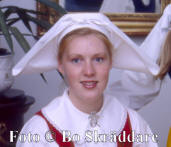
Here soma quotes from a series of articles from 1909 in
wich she describes her creation:
ALLMÄNNA SVENSKA NATIONALDRÄKTEN (the Swedish National Costume) hs bees designed
in accordance with the principle of granting as much room as possible to
differente tastes, "naturally within the limits of style, cut and fabric."
(As far as we know, SVENSKA DRÄKTEN has originally only been made of wool).
"This means that the costume can be made in two
different models".
"The first model is orginally accepted design with the skirt and the
bodice (=laced vest) as separate pieces and the second way, accepted later,
is the (short) bodice and the skirt to be worn (and sewn) together (LIVKJOL),
a design wich originates from Vingåker in the province of Södermanland (and the
style used of Crown Princess Viktoria) and the apron in yellow".
"The skirt and bodice can both be made of cloth in the
now
established 'Swedish' blue color, or with the skirt alone in this hue and
the bodice in bright red."
(Both the blue and the yellow must be in the more subdued tones of the turn of
the century Swedish flag in wool, not the bright colors of today's flag in
cotton or
synthetic material,)
"In addition we need the bright colors of the peasant
costumes. They have an
invigorating effect on our censes that is all to often
underestimated and 'they are
necessary as a contrast to the deep green pine
forest and teh white snow' - as the great artist Carl Larsson writes in "ETT
HEM" (A Home)."
"there are two different headgears wish can be worn."
"The stockings should be black unless red is used in
teh costume in wich case they should be red."
"Shoes, preferably with straps or laces, in black, never
yellow (=brown)."
Unfortunately, SVENSKA DRÄKTEN did not catch on, in spite
of the patriotism of that time. After the First World War, nationalism declined
and the idea of a National Costume was forgotten, although Märta Jörgensen
continued to use hers until her death in 1967.
But in the last few years SVENSKA DRÄKTEN has experienced a renaissance which we
wish Märta Jörgensen could have witnessed. It is becoming increasingly popular
and will probably become the single most used form of folk dress in Sweden.
The woman's and the girl's costume we provide material
for are faithful copies of the oldest exemples of SVENSKA DRÄKTEN of wich we are
aware, both in style and fabric. We have a very light wool in skirt and bodice,
and a slip in pure cotton to keep you cool and comfortable even when the weather
is warm. And it does not crumpled as much as a costume in cotton.
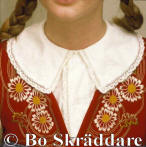
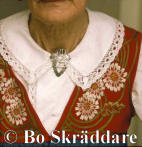
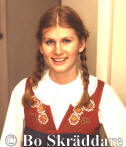
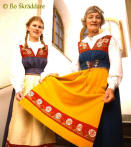
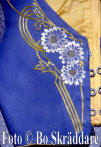
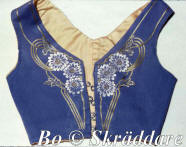
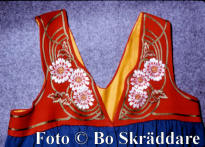

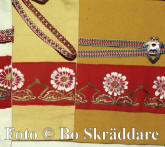
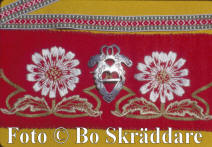
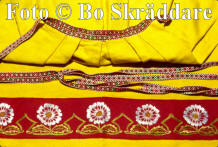
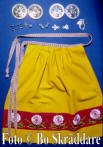
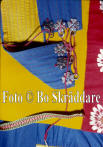
Photo on a daughter / granddaughter of the pupill at
the school in Falun with Märta Jörgensen as teacher.
BUT WHAT ABOUT THE
MEN AND THE BOYS ??
After having written a number of
articles in LAND (one of the largest weekly papers in Sweden) we receives so
many questuins that Bo Skräddare (=Bo 'Tailor') created a SVENSKA DRÄKTEN for
men (NYA SVENSKA MANSDRÄKTEN, The New Swedish Costume for Men) in 1982. Bo
Skräddare's guiding principle was to design a costume for men that would agree
in both style and period with Marta Jörgensen's costume for women.
The result was an embroidered vest in the some colors as the woman's bodice in
'Swedish blue' and bright red, with pants in navy blue or black and a silk
kershief to a stiff-collared shirt.
An elegant escort to a stylish woman in the
beautiful SVENSKA DRÄKTEN !
Nationalism and fashion come and go. now, both 'National
Costumes' and 'Folkdräkter' are more popular then ever, and our new Queen Silvia
did what Queen Viktoria never did, she wore SVENSKA DRÄKTEN on our first
National Day, the
sixth of June 1983, (and our second 1984 and all
following, as well).
 And in August 1984 Sweden got a new Queen, the Queen of Beauty, Miss Universe,
former Miss Sweden, the then 21-year old Yvonne Ryding from Eskilstuna, Of
course she wore SVENSKA DRÄKTEN, made by SVENSKA DRÄKTEN.
And in August 1984 Sweden got a new Queen, the Queen of Beauty, Miss Universe,
former Miss Sweden, the then 21-year old Yvonne Ryding from Eskilstuna, Of
course she wore SVENSKA DRÄKTEN, made by SVENSKA DRÄKTEN.
'The beautiful smile and the National Costume gave her many extra points' as a
Swedish paper wrote.
With love from Bo Skräddare, SVENSKA DRÄKTEN, Sweden.
Especially for: BO SKRÄDDARE / SVENSKA DRÄKTEN.
Ågestavägen 27, STUVSTA.
S-141 37 STOCKHOLM-HUDDINGE. SWEDEN.
Phone 46 (0)8 711 4060.
 Åter till sida ett. Back to Main page.
Åter till sida ett. Back to Main page.
Email: 
This article may be copied freely, provided the
source is given.
Writer: Bo Skräddare, SVENSKA DRÄKTEN, Stockholm.



















